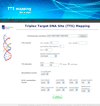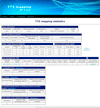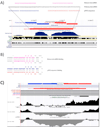TTS mapping: integrative WEB tool for analysis of triplex formation target DNA sequences, G-quadruplets and non-protein coding regulatory DNA elements in the human genome
- PMID: 19958507
- PMCID: PMC2788396
- DOI: 10.1186/1471-2164-10-S3-S9
TTS mapping: integrative WEB tool for analysis of triplex formation target DNA sequences, G-quadruplets and non-protein coding regulatory DNA elements in the human genome
Abstract
Background: DNA triplexes can naturally occur, co-localize and interact with many other regulatory DNA elements (e.g. G-quadruplex (G4) DNA motifs), specific DNA-binding proteins (e.g. transcription factors (TFs)), and micro-RNA (miRNA) precursors. Specific genome localizations of triplex target DNA sites (TTSs) may cause abnormalities in a double-helix DNA structure and can be directly involved in some human diseases. However, genome localization of specific TTSs, their interconnection with regulatory DNA elements and physiological roles in a cell are poor defined. Therefore, it is important to identify comprehensive and reliable catalogue of specific potential TTSs (pTTSs) and their co-localization patterns with other regulatory DNA elements in the human genome.
Results: "TTS mapping" database is a web-based search engine developed here, which is aimed to find and annotate pTTSs within a region of interest of the human genome. The engine provides descriptive statistics of pTTSs in a given region and its sequence context. Different annotation tracks of TTS-overlapping gene region(s), G4 motifs, CpG Island, miRNA precursors, miRNA targets, transcription factor binding sites (TFBSs), Single Nucleotide Polymorphisms (SNPs), small nucleolar RNAs (snoRNA), and repeat elements are also mapped based onto a sequence location provided by UCSC genome browser, G4 database http://www.quadruplex.org and several other datasets. The results pages provide links to UCSC genome browser annotation tracks and relative DBs. BLASTN program was included to check the uniqueness of a given pTTS in the human genome. Recombination- and mutation-prone genes (e.g. EVI-1, MYC) were found to be significantly enriched by TTSs and multiple co-occurring with our regulatory DNA elements. TTS mapping reveals that a high-complementary and evolutionarily conserved polypurine and polypyrimidine DNA sequence pair linked by a non-conserved short DNA sequence can form miR-483 transcribed from intron 2 of IGF2 gene and bound double-strand nucleic acid TTSs forming natural triplex structures.
Conclusion: TTS mapping provides comprehensive visual and analytical tools to help users to find pTTSs, G-quadruplets and other regulatory DNA elements in various genome regions. TTS Mapping not only provides sequence visualization and statistical information, but also integrates knowledge about co-localization TTS with various DNA elements and facilitates that data analysis. In particular, TTS Mapping reveals complex structural-functional regulatory module of gene IGF2 including TF MZF1 binding site and ncRNA precursor mir-483 formed by the high-complementary and evolutionarily conserved polypurine- and polypyrimidine-rich DNA pair. Such ncRNAs capable of forming helical triplex structures with a polypurine strand of a nucleic acid duplexes (DNA or RNA) via Hoogsteen or reverse Hoogsteen hydrogen bonds. Our web tool could be used to discover biologically meaningful genome modules and to optimize experimental design of anti-gene treatment.
Figures









Similar articles
-
The TTSMI database: a catalog of triplex target DNA sites associated with genes and regulatory elements in the human genome.Nucleic Acids Res. 2015 Jan;43(Database issue):D110-6. doi: 10.1093/nar/gku970. Epub 2014 Oct 16. Nucleic Acids Res. 2015. PMID: 25324314 Free PMC article.
-
Polypurine reverse-Hoogsteen (PPRH) oligonucleotides can form triplexes with their target sequences even under conditions where they fold into G-quadruplexes.Sci Rep. 2017 Jan 9;7:39898. doi: 10.1038/srep39898. Sci Rep. 2017. PMID: 28067256 Free PMC article.
-
A web-based search engine for triplex-forming oligonucleotide target sequences.Oligonucleotides. 2006 Summer;16(2):196-201. doi: 10.1089/oli.2006.16.196. Oligonucleotides. 2006. PMID: 16764543
-
Transposable elements and G-quadruplexes.Chromosome Res. 2015 Sep;23(3):615-23. doi: 10.1007/s10577-015-9491-7. Chromosome Res. 2015. PMID: 26403244 Review.
-
Gene Correction of Point Mutations Using PolyPurine Reverse Hoogsteen Hairpins Technology.Front Genome Ed. 2020 Oct 29;2:583577. doi: 10.3389/fgeed.2020.583577. eCollection 2020. Front Genome Ed. 2020. PMID: 34713221 Free PMC article. Review.
Cited by
-
Triplexator: detecting nucleic acid triple helices in genomic and transcriptomic data.Genome Res. 2012 Jul;22(7):1372-81. doi: 10.1101/gr.130237.111. Epub 2012 May 1. Genome Res. 2012. PMID: 22550012 Free PMC article.
-
Functional Prediction of Candidate MicroRNAs for CRC Management Using in Silico Approach.Int J Mol Sci. 2019 Oct 19;20(20):5190. doi: 10.3390/ijms20205190. Int J Mol Sci. 2019. PMID: 31635135 Free PMC article.
-
Extending Asia Pacific bioinformatics into new realms in the "-omics" era.BMC Genomics. 2009 Dec 3;10 Suppl 3(Suppl 3):S1. doi: 10.1186/1471-2164-10-S3-S1. BMC Genomics. 2009. PMID: 19958472 Free PMC article.
-
Selective Preference of Parallel DNA Triplexes Is Due to the Disruption of Hoogsteen Hydrogen Bonds Caused by the Severe Nonisostericity between the G*GC and T*AT Triplets.PLoS One. 2016 Mar 24;11(3):e0152102. doi: 10.1371/journal.pone.0152102. eCollection 2016. PLoS One. 2016. PMID: 27010368 Free PMC article.
-
Triplex technology in studies of DNA damage, DNA repair, and mutagenesis.Biochimie. 2011 Aug;93(8):1197-208. doi: 10.1016/j.biochi.2011.04.001. Epub 2011 Apr 11. Biochimie. 2011. PMID: 21501652 Free PMC article. Review.
References
Publication types
MeSH terms
Substances
LinkOut - more resources
Full Text Sources
Miscellaneous

